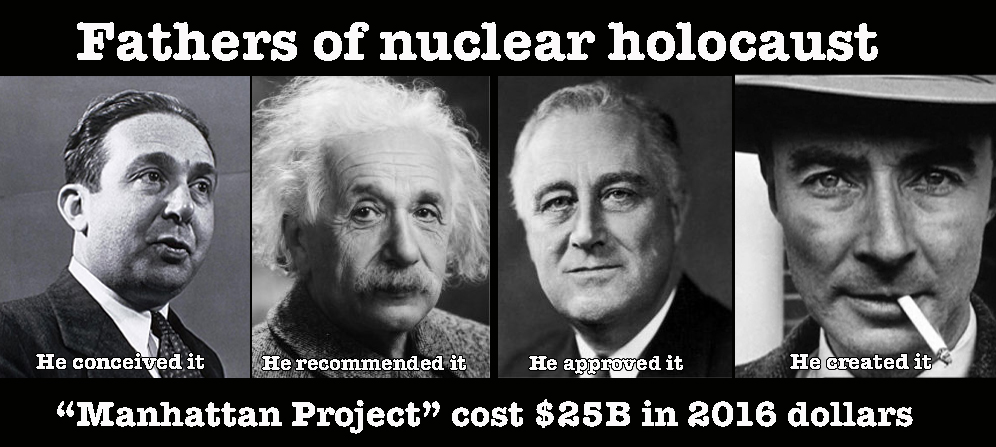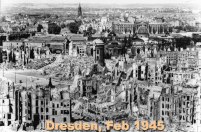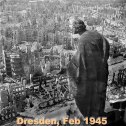
On this day, Aug 6, 1945, some 70,000 people perished in Hiroshima, Japan, in what is possibly the single worst war crime in the history of mankind (some 25,000 died in the firebombing of Dresden in Feb 1945). Another 70,000 or so are believed to have died of radiation that followed the “Enola Gay” strike.
Deafening New World Order Media Silence
This morning, I burned Frankincense, Myrrh and Palo Santo and sprinkled Holy Water in memory of these victims of the first ever nuclear strike. But when I went online to see what other commemorations of this terrible event were taking place around the world, I could not find a single news item about it among the day’s top stories. But they did include Tiger Woods’ injury and same-sex marriage. And this five-year old story about Hiroshima from Boston.com.
“O tempora, o mores.” The times we live in! The zombies the New World Order is creating in our counrtry (see “Dumbing Down of America“).
Well, if you are reading these lines, at least you are not one of them. So I invite you to join me in a minute of silence to honor the victims of the world’s first nuclear bomb. And then reflect on what maybe 500 million dead might look like if the current New World Order plans come to pass (see Parallel Wars).
HIROSHIMA REQUIEM
I recorded and posted this musical creation on VE-Day.
Today, Aug 6, 2014 – I am rededicated it as HIROSHIMA REQUIEM.
Amazingly, I just realized that my original recording of the Beatles song Hey Jude took place on this very day two years ago! So it was meant to be…
That was the opening line of my first recording of a blend of the famous Pachelbel and Beatles’ tunes (see “Hey Dude,” Aug 6, 2012). Pachelbel’s “Canon in D” had come to me just over a month before (see Jamming with Pachelbel: St Vitus Day 2012 Peace Offering, 6-28-12). Paul McCartney jogged my musical memory with an outstanding performance of “Hey Jude” at the opening of the London 2012 Olympics.
* * *
UPDATE AUGUST 9, 2017
REMEMBERING THE NAGASAKI VICTIMS OF U.S. ATOM BOMB
On this day in 1945, a second atom bomb was dropped on Japan by the United States, at Nagasaki, resulting in 60,000 to 80,000 deaths, in addition to 140,000 to 150,000 killed in Hiroshima on Aug 6 (exact figures are impossible to obtain, the blast having obliterated bodies and disintegrated records).
The United States had already planned to drop their second atom bomb, nicknamed “Fat Man,” on August 11, but bad weather expected for that day pushed the date up to August 9th. So at 1:56 a.m., a specially adapted B-29 bomber, called “Bock’s Car,” after its usual commander, Frederick Bock, took off from Tinian Island under the command of Maj. Charles W. Sweeney.
The bomb was dropped at 11:02 a.m., 1,650 feet above the city. The explosion unleashed the equivalent force of 22,000 tons of TNT. The hills that surrounded the city did a better job of containing the destructive force, but the number of people killed was still horrific.
MORTALITY ESTIMATES: OVER 225,000 PEOPLE KILLED IN TWO STRIKES
The real mortality of the atomic bombs that were dropped on Japan will never be known. The destruction and overwhelming chaos made orderly counting impossible. It is not unlikely that the estimates of killed and wounded in Hiroshima (150,000) and Nagasaki (75,000) are over conservative.
At no time during the period between 1943 and 1946 were facilities allotted, or time provided, for the Medical Section of the Manhattan Engineer District to prepare a comprehensive history of its activities. Regulations forbade notetaking. Official records were scanty. There were few charts and photographs.
From their own observations and from testimony of Japanese, members of the survey team divided the morbidity and mortality of the atomic bombs that were dropped on Japan into the following phases:
- Very large numbers of person were crushed in their homes and in the buildings in which they were working. Their skeletons could be seen in the debris and ashes for almost 1,500 meters from the center of the blast, particularly in the downwind directions.
- Large numbers of the population walked for considerable distances after the detonation before they collapsed and died.
- Large numbers developed vomiting and bloody and watery diarrhea (vomitus and bloody fecees were found on the floor in many of the aid stations), associated with extreme weakness. They died in the first and second weeks after the bombs were dropped.
- During this same period deaths from internal injuries and from burns were common. Either the heat from the fires or infrared radiation from the detonations caused many burns, particularly on bare skin or under dark clothing.
- After a lull without peak mortality from any special causes, deaths began to occur from purpura, which was often associated with epilation, anemia, and a yellowish coloration of the skin. The so-called bone marrow syndrome, manifested by a low white blood cell count and almost complete absence of the platelets necessary to prevent bleeding, was probably at its maximum beTween the fourth and sixth weeks after the bombs were dropped.
DID THE ATOMIC BOMB WIN THE WAR AGAINST JAPAN?
NO, FOR JAPAN WAS ALREDY READY TO SURRENDER (several sources)
General Curtis LeMay, Air Force Commander: “The atomic bomb had nothing to do with the end of the war at all” (Sep 29, 1945)
General Dwight Eisenhower: “Japan was already defeated and that dropping the bomb was completely unnecessary… I thought that our country should avoid shocking world opinion by the use of a weapon whose employment was, I thought, no longer mandatory as a measure to save American lives. It was my belief that Japan was, at this very moment, seeking a way to surrender with a minimum loss of ‘face.’”
President Herbert Hoover: “The use of the Atomic bomb on Japan has continued to stir the American conscience as well as the conscience of thinking people elsewhere in the world. Attempts have been made to justify the use of this terrible weapon. However, American military men and statesmen have repeatedly stated its use was not necessary to bring the war to an end.” (Excerpt from Herbert Hoover’s “Freedom Betrayed.” This is from chapter 83 (Aftermath of Dropping the Atomic Bomb on Japan), 566-568.)
Gar Alperowitz, a political economist and historian who is Professor of Economy at the University of Maryland, notes, p. 16, “On May 5, May 12 and June 7, the Office of Strategic Services (our intelligence operation), reported Japan was considering capitulation. Further messages came on May 18, July 7, July 13 and July 16.”
Alperowitz also points out, p.36, “The standing United States demand for ‘unconditional surrender’ directly threatened not only the person of the Emperor but such central tenets of Japanese culture as well.”
Alperowitz also quotes General Curtis LeMay, chief of the Air Forces, p.334, “The war would have been over in two weeks without the Russians entering and without the atomic bomb. PRESS INQUIRY: You mean that, sir? Without the Russians and without the atomic bomb? LeMay: The atomic bomb had nothing to do with the end of the war at all.” September 29, 1945, statement.
Admiral William Leahy, FDR’s chief of staff, stated in “I Was There,” a memoir, “my own feeling is that being the first to use it (the atomic bomb) we had adopted an ethical standard common to the Barbarism of the Dark Ages. I was not taught to make war in that fashion, and wars cannot be won by destroying women and children.”
AMERICAN MILITARY AUTHORITIES SAY ATOMIC BOMBING WAS UNNECESSARY
CHURCH LEADERS, STATESMEN, AND MEDIA ALSO CONDEMNED IT
Most apologists for the American nuclear strikes on Japan argue that these bombings actually forced Japan to surrender and thus saved lives. Such a theory is contradicted by facts. General LeMay, for example, the Air Force chief of staff at the time, said in a media interview, “the atomic bomb had nothing to do with the end of the war at all” (Sep 29, 1945).
The most authoritative Air Force unit during World War II was the U.S. Strategic Bombing Survey, which selected targets on the basis of need, and which analyzed the results for future missions.
In Hiroshima’s Shadow, the U.S. Strategic Bombing Survey report of July 1, 1946 states, “The Hiroshima and Nagasaki atomic bombs did not defeat Japan, nor by the testimony of the enemy leaders who ended the war did they persuade Japan to accept unconditional surrender. The Emperor, the lord privy seal, the prime minister, the foreign minister, and the navy minister had decided as early as May 1945 that the war should be ended even if it meant acceptance of defeat on allied terms…. It is the Survey’s opinion that certainly prior to December 1, 1945 and in all probability prior to November 1, 1945, Japan would have surrendered even if the atomic bombs had not been dropped and even if no invasion had been planned or contemplated.”
Both military, political and religious leaders spoke out against the atomic bombing of Japanese civilians. The Federal Council of the Churches of Christ in America issued a formal statement in March 1946 (cited by Gar Alperowitz):
“The surprise bombings of Hiroshima and Nagasaki are morally indefensible. Both bombings must be judged to have been unnecessary for winning the war. As the power that first used the atomic bomb under these circumstances, we have sinned grievously against the laws of God and against the people of Japan.” (Commission on the Relation of the Church to the War in the Light of the Christian Faith).
On p.438, Gar Alperowitz quotes James M. Gillis, editor of Catholic World, “I would call it a crime were it not that the word ‘crime’ implies sin, and sin requires a consciousness of guilt. The action taken by the Untied States government was in defiance of every sentiment and every conviction upon which our civilization is based.”
One of the most vociferous critics of the atomic bombings was David Lawrence, founder and editor of U.S. News and World Report. He signed a number of stinging editorials, the first on August 17, 1945.
“Military necessity will be our constant cry in answer to criticism, but it will never erase from our minds the simple truth, that we, of all civilized nations, though hesitating to use poison gas, did not hesitate to employ the most destructive weapon of all times indiscriminately against men, women and children.” On October 5, Lawrence continued his attack, “The United States should be the first to condemn the atomic bomb and apologize for its use against Japan. Spokesmen for the Army Air Forces said it wasn’t necessary and that the war had been won already. Competent testimony exists to prove that Japan was seeking to surrender many weeks before the atomic bomb came.”
On November 23, Lawrence wrote, “The truth is we are guilty. Our conscience as a nation must trouble us. We must confess our sin. We have used a horrible weapon to asphyxiate and cremate more than 100,000 men, women and children in a sort of super-lethal gas chamber and all this in a war already won or which spokesman for our Air Forces tell us we could have readily won without the atomic bomb. We ought, therefore, to apologize in unequivocal terms at once to the whole world for our misuse of the atomic bomb.”
David Lawrence was an avowed conservative, a successful businessman, who knew eleven presidents of the United States intimately, and was awarded the Medal of Freedom by President Richard M. Nixon, April 22, 1970.
And even Einstein, who started the nuclear ball rolling in the US was ultimately apologetic about it. See his comment below.

(Some of the excerpts were taken from WHY HIROSHIMA WAS DESTROYED: SECRET HISTORY OF THE ATOMIC BOMB – http://www.whale.to/b/mullins8.html – The Untold Story – by Eustace C. Mullins – June 1998).
UPDATE AUGUST 9, 2017
MEET THE FATHERS OF NUCLEAR HOLOCAUST

ATOMIC TERRORISM
Hungarian physicist Leo Szilard (1898–1964) conceived the idea of the nuclear chain reaction in 1933, and immediately became concerned that, if practical, nuclear energy could be used to make weapons of war. Szilard, a Jew who fled Nazi persecution first in his native Hungary, then again in Germany, conveyed his concerns to his friend and contemporary, noted physicist Albert Einstein (1879–1955).
In 1939, the two scientists drafted a letter (addressed from Einstein) warning United States President Franklin D. Roosevelt of the plausibility of nuclear weapons, and of German experimentation with uranium and fission.
When Einstein arrived in the United States, he was feted as a famous scientist, and was invited to the White House by President and Mrs. Roosevelt. He was soon deeply involved with Eleanor Roosevelt in her many leftwing causes, in which Einstein heartily concurred.
Einstein’s letter to Roosevelt, dated August 2, 1939, was delivered personally to President Roosevelt by Alexander Sachs on October 11, 1939.
Why did Einstein enlist an intermediary to bring this letter to Roosevelt, with whom he was on friendly terms? The atomic bomb program could not be launched without the necessary Wall Street sponsorship. Sachs, a Russian Jew, listed his profession as “economist” but was actually a bagman for the Rothschilds, who regularly delivered large sums of cash to Roosevelt in the White House.
Sachs was an advisor to Eugene Meyer of the Lazard Freres International Banking House, and also with Lehman Brothers, another well known banker. Sachs’ delivery of the Einstein letter to the White House let Roosevelt know that the Rothschilds approved of the project and wished him to go full speed ahead.
“MANHATTAN PROJECT”
The atomic bomb was developed at the Los Alamos Laboratories in New Mexico. The top secret project was called the Manhattan Project, because its secret sponsor, Bernard Baruch, lived in Manhattan, as did many of the other principals. Baruch had chosen Maj. Gen. Leslie R. Groves in 1942 to head the operation. Groves had previously built the Pentagon, and had a good reputation among the Washington politicians.
The scientific director at Los Alamos was J. Robert Oppenheimer, scion of a prosperous Jewish family of clothing merchants. In “Oppenheimer; the Years Of Risk,” by James Kunetka, Prentice Hall, NY, 1982, Kunetka writes, p. 106, “Baruch was especially interested in Oppenheimer for the position of senior scientific adviser.”
The first successful test of the atomic bomb occurred at the Trinity site, 200 miles south of Los Alamos at 5:29:45 a.m. on July 16, 1945. Oppenheimer was beside himself at the spectacle. He shrieked, “I am become Death, the Destroyer of worlds.”
From Wikipedia:
“Manhattan Project Cost ($25 billion in 2016 dollars)
| Site | Cost (1945 USD) | Cost (2016 USD) | % of total |
|---|---|---|---|
| Oak Ridge | $1.19 billion | $15.8 billion | 62.9% |
| Hanford | $390 million | $5.19 billion | 20.6% |
| Special operating materials | $103 million | $1.38 billion | 5.5% |
| Los Alamos | $74.1 million | $985 million | 3.9% |
| Research and development | $69.7 million | $927 million | 3.7% |
| Government overhead | $37.3 million | $496 million | 2.0% |
| Heavy water plants | $26.8 million | $356 million | 1.4% |
| Total | $1.89 billion | $25.1 billion |
Over 90% of the cost was for building plants and producing the fissionable materials, and less than 10% for development and production of the weapons.
By comparison, the project’s total cost by the end of 1945 was about 90% of the total spent on the production of US small arms (not including ammunition), and 34% of the total spent on US tanks during the same period.
A total of four weapons (the Trinity gadget, Little Boy, Fat Man, and an unused bomb) were produced by the end of 1945, making the average cost per bomb around $500 million in 1945 dollars ($6.6 billion in 2016 dollars).


















Leave a comment